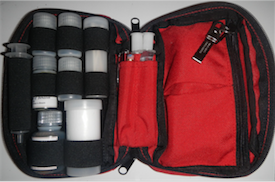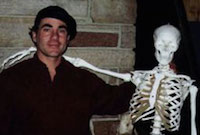Building Your Wilderness First Aid Kit
by Paul Nicolazzo
Director, Wilderness Medical Training Center
Whether you are traveling alone, taking part in an expedition or climbing course, or responding as a member of a search & rescue (SAR) team, you will need an appropriate first aid kit. What you should take and how you should package it depends on many things. Here are three basic guidelines to help you build an effective kit:
Tip #1: Design your first aid kit with your trip in mind.

Customize your wilderness first aid kit for each new trip. Photo: Paul Nicolazzo
There is no generic first aid kit. The type and length of activity or expedition defines what you will want to have in your kit. Generally, the further you are from "help," the bigger your first aid kit will be. If you are on a very long trip, you will also need to consider whether or not you will need to set up a resupply. Also, the level of training of the medical "officer" will limit how much invasive equipment or Rx drugs you can carry.
First aid kits used by expeditions are conceptually very different from those used by rescue teams. Expeditions hope that they will NOT use their first aid kits and adhere to the principles of improvisation: they limit specialized items, focus on multipurpose equipment, and adapt expedition gear for medical uses (for example, using skis for splints and sleds for litters). As your ability to improvise increases, the size of your expedition first aid kit decreases. Rescue teams, on the other hand, know they WILL use their equipment and often carry specialized gear with them rather than scavenging their personal gear for improvisation.
It is important to examine the medical history of each team member; you may need to add special equipment or drugs to your kit. Pay attention to any allergies. If your experience in wilderness medicine is limited, look over Wilderness Medical Training Center's (WMTC) publications and consider carrying their Wilderness Medicine Handbook. You should also consider carrying SOAP Notes to thoroughly document your assessment and treatment of injured team members. You may download a copy of WMTC's Patient SOAP notes from their website for free (print on rite-in-the-rain paper) or purchase them directly from WMTC.
Tip #2: Organize your first aid kit effectively.
Packaging that is organized and well thought-out protects valuable and irreplaceable equipment. It permits fast and easy access to emergency gear without "vomiting" kit contents everywhere. Critical concepts to organization and packaging are:
- Use different colored compartments or packs. DO NOT use plastic bags as pack or compartment substitutes.
- Clearly label each compartment or pack: In many expeditions each expedition member carries their own personal care kit (blisters, sun screen, OTC meds, personal Rx meds, minor cuts & scrapes, etc.) leaving the expedition first aid kit for emergencies and minor trauma (more serious wounds and unstable injuries). This helps ensure that the expedition first aid kit is complete when it is needed.
- Laminate a contents list for each pack and indicate the intended use for each item.
- Seal soft goods in plastic to protect them from moisture. Use individual mini zip-locks or "Seal-a-Meal" freezer type packages.
- Tubes break. Repackage ointments into one and two ounce wide mouth (or larger depending on group size) Nalgene bottles.
- Liquids leak. Package liquids in one and two ounce narrow mouth (or larger depending on group size) Nalgene bottles.
- Use a weatherproof drug log for ALL medications so that you know who is using them and why.
- Train your expedition or team members to use your kit. Until they are trained, only you know why you assembled the kit as you did. Without specific training most people will not know how to use the equipment you have so thoughtfully assembled. Restrict access to compartments or packs that members are not trained to use.
Tip #3: Anticipate possible problems.
An effective first aid kit is built from a comprehensive "possible problem list." Divide your list into Basic Life Support or Trauma, Environmental, and Medical problems. Choose the problems that you will likely encounter and prioritize them. Once you are satisfied with your possible problem list, compile a list of first aid supplies needed to treat them; carry more of the stuff that you WILL need. Below is a basic checklist of potential problems; use this list as a guide as you build your trip-specific first aid kit.
| Possible Major Trauma and Basic Life Support Problems: |
|
Respiratory Arrest
♦ Mask or face shield (or go mouth-to-mouth)
No Pulse
♦AED (useful only if ALS is within hours)
Severe Bleeding
♦ Trauma scissors
♦ Trauma gloves
♦ Trauma dressings (maxi-pads, diapers)
♦ Elastic wraps, coban (vet wrap) for pressure bandages
|
 |
Vomiting
♦60 cc suction syringe & tube
Unstable Spine Injury
♦ SAM splint (for improvised C-collar)
♦ Improvise a backboard or litter from expedition equipment
V, P, or U (Voice responsive, Pain responsive, or Unresponsive
♦ Emergency Action Plan
♦ Cell phone or radio
|
| Possible Minor Trauma Problems: |
|
Wounds, Blisters, & Infection
♦ Irrigation syringe
♦ Scalpel & blades and/or surgical scissors
♦ Forceps or tweezers
♦ Exam gloves
♦ Povidone Iodine solution for cleaning high risk wounds
♦ Herbs & antibiotics (topical & oral)
♦ Tincture of benzoin
♦ Cloth tape
♦ Second Skin for treating blisters
♦ ShearBan/ENGO for blister prevention & treatment
♦ Tegaderm micro thin film dressing
♦ Roller gauze for dressings
♦ Coban for holding dressing in place
|
 |
Stable & Unstable Musculoskeletal Injuries
♦ Improvise a cast, sandwich, jelly roll, or buddy splint
from expedition equipment
♦ SAM splint
♦ Coban (veterinarian wrap)
♦ Pain & aniti-inflammatory drugs & herbs
|
| Possible Environmental Problems: |
|
Hypothermia
♦ Hypothermia thermometer
♦ Space blanket or space bag for inner vapor barrier
of hypothermia package
♦ Improvise hypothermia package & heat packs (hydro-packs,
water bottles, etc.) from expedition equipment
Heat Stroke
♦ Mist bottle for cooling in arid climates
♦ Digital thermometer
Heat Exhaustion & Dehydration
♦ WHO Oral Rehydration Solution
Sunburn
♦ Sun block
♦ Aloe vera & vitamin E gels
Second Degree Thermal Burns
♦ Silver sulfadiazine ointment (Rx) or white petroleum jelly
♦ Tegaderm micro thin film dressing
♦ Roller gauze for dressings
|
 |
Ingested Toxins
♦ Activated charcoal slurry
Allergies
♦ Epinephrine (Rx)
♦ Oral antihistamine
Poison Ivy, Oak, & Sumac
♦ Pre-exposure lotion
♦ Technu Oak & Ivy Cleanser (post-exposure soap)
♦ Hydrocortisone cream (treatment)
Acute Mountain Sickness
♦ Gamow bag
♦ Herbs: ginko biloba
♦ Rx drugs: acetazolamide, dexamethasone, & nifedipine
|
| Possible Medical Problems: |
|
Disease
♦ Disease specific Rx antibiotics & antimicrobials
♦ Grapefruit seed extract
♦ Disease specific herbs
Diabetes
♦ Glucose tabs, paste, or similar product (OTC)
♦ Glucagon injections (Rx)
Asthma
♦ Rx medication (oral, inhalers)
♦ Injectable epinephrine (Rx)
Water Treatment
♦ Boiling
♦ Filter
♦ Iodine or two-part chlorine tablets
♦ Grapefruit seed extract
|
 |
Ears
♦ Irrigation syringe
♦ Vinegar or Rx antibiotic drops
Eyes
♦ Irrigation syringe
♦ Rx antibiotic ointment
♦ Herbal wash
Teeth
♦ Cavit (temporary filling without Oil of Clove)
♦ DenTemp (temporary filling with Oil of Clove)
♦ Oil of clove (pain relief)
|

Paul Nicolazzo and friend.
Paul Nicolazzo founded the Wilderness Medicine Training Center (WMTC) in 1997 and continues to serve as the center's owner, director, and head instructor. Paul has been active in search and rescue since 1977, has taught wilderness medicine around the world, and has acted as an outdoor skills consultant and staff trainer for each of the US-based Outward Bound Schools, as well as numerous private and state schools, colleges, and outfitters. When at home in Mazama, Washington, he is an active WEMT who responds with the Methow Valley SAR and Nordic ski patrol. Paul is the author of numerous books on wilderness medicine and risk management, and in between teaching first aid courses, he writes a medical column for Off-Piste Magazine and occasional articles for WaveLength Magazine. He continues to guide, teach, rescue, and find time to enjoy his own expeditions.
Based in Mazama, Washington, the WMTC offers year-round courses in Wilderness First Responder (and WFR recert), Wilderness EMT, Wilderness First Aid, wilderness survival, technical rescue, and risk management. Contact the WMTC by email [email protected] by phone at 509-996-2502 with questions on courses and availability.
The Wilderness First Responder (WFR) course is the standard emergency medicine curriculum for climbers, backpackers, kayakers, and other wilderness enthusiasts, and is a prerequisite for guiding careers.
Program Finder